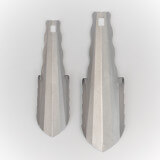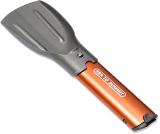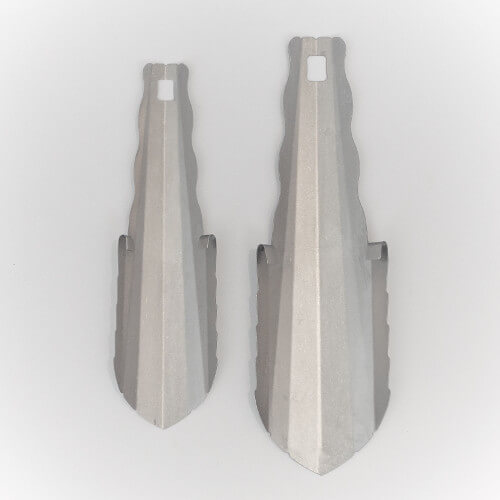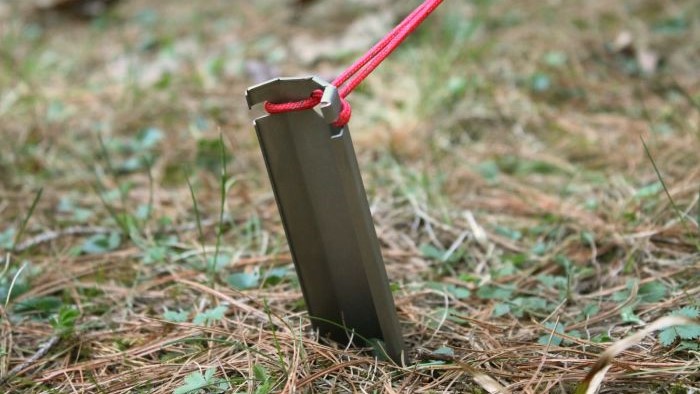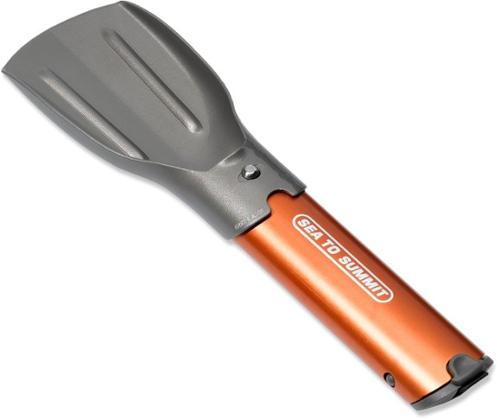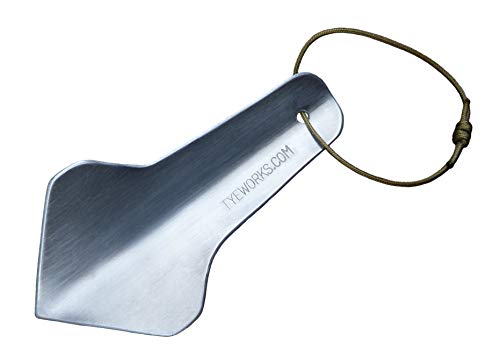Updated November 2019
Best Backpacking Shovels & Trowels [2019 Buyer’s Guide]
No, we’re not talking about a long handled wooden shovel.
We’re also not talking about those military backpacking shovels that fold in half and weigh an insane amount. So what constitutes a backpacking shovel or trowel for this article? We’re talking about poop trowels for properly disposing of human waste.
In the backpacking world, it’s important to properly take care of the areas we use and travel in. Not only are we protecting the natural resources but we’re also trying to provide a good experience for the next visitor. For those reasons, it’s critical to follow LNT guidelines when disposing of human waste properly in the wilderness. One way to do this is using a trowel to dig a hole and cover your waste.
More...
I’ll share with you a nasty story that illustrates exactly why this is so important in just a minute. But if you’re rather skip ahead to the more practical stuff, just click one of the links below:
Comparison Chart
Name | Price | Weight | Rating | Notes |
|---|---|---|---|---|
$$$ | 4 oz | Folds for compact storage; made from durable stainless steel | ||
$$$ | 0.67 oz | Ultralight backpacking trowels made from Titanium | ||
$$$ | 0.6 oz | Made from strong, tough 7075-T6 aluminum | ||
$$$ | 4 oz | Ideal for digging up or transporting large scoops of soil; Made of Nyglass nylon/fiberglass composite | ||
$$$ | 1.6 oz | Inspired by the Japanese Hori-Hori Knife, award-winning Titanium Dig Dig Tool makes quick work of digging | ||
$$$ | 1.6 oz | Tough, single piece plastic construction stays strong in hard, dry soils | ||
$$$ | 3.5 oz | Lightweight aluminum alloy handle and hard-anodized aluminum blade | ||
$$$ | 1 oz | Cut from 16 gauge (1/16") aluminum sheet, hand shaped & polished | ||
$$$ | 8 oz | Made of stainless steel which is high-strength and wear-resistant |
Why bury waste? (a shitty story)
Allow me to start with a little anecdote.
When guiding a trip on the Appalachian Trail several years back I took off my backpack during a rest break and set it against a tree no more than a foot from the trail. After our break was over I picked up my bag and put it on. Unfortunately, something smelled AWFUL so I started checking around. Turns out I had set my backpack right in a pile of human poop no more than a single pace off of the trail. It was fresh, too!
Needless to say, I’m not a big fan of having fresh turds smeared all over the bottom of my pack. What really made the whole situation worse, however, was that it seemed representative of a culmination of misuse. After a summer of guiding on the southern section of the AT, I was at my wits end from seeing scenes of recreational misuse of public lands.
Toilet paper carelessly tossed aside litters the area around each shelter like a blanket of fresh snow. Fire rings, when people even bother to use them, are full and overflowing with Pop-Tarts wrappers and ramen packaging. Saplings have been shredded by trigger-happy hikers who just had to find something to chop with their camp axes.
As recreational use of public lands (and recreational density in popular areas) picks up it becomes ever more important that each of us does our part to minimize our individual impacts on the areas we choose to recreate. That’s where backpacking trowels become so important.
How to choose the best backpacking trowel
Weight
I always include weight as a priority consideration on any backpacking gear. When it comes to trowels and shovels they can weigh anywhere from 0.5 ounces up to several pounds. We’ll talk later about different ways backpacking shovels can be used but 99% of backpackers use them only for digging human waste catholes. For this reason, we simply need something small, effective, and lightweight.
To the best of my knowledge, the Suluk46 Tark Trowel remains the lightest trowel on the market that I would deem “minimally sufficient” for digging a proper cathole. Therefore we will consider the 13 gram (0.46-ounce) weight of the Tark Trowel as the ultralight benchmark for comparison across the market.
Generally trowel weight varies based on design and materials.
Features & Functions
There are very few functions and features that really matter in a backpacking shovel because, well… it’s a shovel. Let’s not over complicate it. However, some common features that are useful include folding handles and serrated edges.
Folding handles are nice on many products because they can cut the size of the trowel in half when folded. Maximizing space in the backpack is always important. When it comes to “cutting” power, just keep in mind that backpacking shovels are NOT AXES. At most, they’re meant to go through tiny, toothpick sized roots. If you’re finding yourself hacking away at finger-sized roots, go dig somewhere else.
Attachments
No, I’m not talking about adding a scope to your trowel. However, having a backpacking shovel that can easily attach to your bag can be helpful. I keep mine clipped to the outside of my bag, along with two MSR mini-groundhog stakes, using a small carabiner. Why? Because I don’t want to have to dig it out when I need to use it. Simply clip it on, and tuck it into an outer pocket to prevent it from swinging around.
Just look for a trowel that has a small hole in the handle or some attachment point for easily clipping it to your backpack. Don’t want it to fall out and get lost!
Materials
Well, here’s the question. Plastic, aluminum, or titanium?
Here are some of the main considerations you should be aware of for each of the popular trowel materials…
Price:
Durability:
Weight:
Titanium, by and large, remains the most expensive but lightest weight trowel type out there. However, thin lightweight aluminum trowels are growing in popularity and many are as durable (or close to) as titanium and usually much cheaper.
I’ve found, however, that buying plastic trowels simply adds up to a higher cost over the life of your trowel. Why? Because plastic backpacking trowels break all the time and you have to buy new ones.
I’d argue that aluminum might be the best price-weight ratio. While titanium is a little lighter, it tends not to matter that much. If weight is your top concern, however, you’ll definitely want a titanium Suluk46 Tark Trowel.
Durability
Durability is one of the biggest concerns for me. I’ve seen no lack of broken trowels and shovels over the years. From shattered folding “army” shovels to broken plastic trowels. Today, more than ever, manufacturers are making inexpensive products that just don’t hold up. That’s why I will advise backpackers to opt for the Outdoor Products Hand Shovel which is a nearly bomb-proof steel folding shovel when looking for raw durability. I’ve used this shovel on group trips for years and love it for its pure tenacity at the hands of overeager diggers!If you’re not sure which shovel is the best pick for you, I’d err on the side of durable, simple, and proven.
On my personal solo trips I go with the Suluk46 Tark trowel (old model) because I prefer the ultralightweight. Sure it’s less durable than an all-steel trowel but I trust myself to use it properly and not mangle it when digging with it. So far it has held up over about 6 years of backpacking! No problem.
The Best Shovels For Backpacking
Overall rating: 4.5 / 5
This has got to be my overall favorite for every situation. I have a personal fave backpacking shovel, but this one takes the cake for most situations. Why?
Because many hikers prefer durability and resilience over lightweight. This trowel is nearly indestructible and will last forever if used properly. I’ve used these mainly on group expeditions with tons of new backpackers. This little steel shovel is light enough to be a good choice, durable enough to stand up to abuse, and very small when folded down.
Overall I think the Outdoor Products Hand Shovel is the best choice for the widest range of backpackers. The full steel construction is ideal for those seeking durability above all else. It’s a simple design, proven product, and solid concept. Nothing revolutionary here, just a trusty product
Overall rating: 5 / 5
Now, this is my personal all-time favorite backpacking trowel. The Suluk46 titanium backpacking trowel is little-known and hyper effective. It’s available in two sizes small (original) or large and each version can be purchased in titanium or aluminum versions. I personally use the small titanium version.
What attracted me to this backpacking shovel originally? The absurdly lightweight, of course! The weight is better measured in grams than ounces. Of course, this means it’s not nearly as indestructible as the OP steel shovel we mentioned earlier. This was a concern of mine at first but after years of use, it still works great!
One thing that surprised me about the shovel is that it’s actually easier to use than larger and heavier shovels. How is that? Because it’s so thin that the shovel actually cuts through minor roots with ease – it’s so thin it’s practically sharpened. Overall this get’s my 5/5 star approval and recommendation.
Overall rating: 4.5 / 5
With the popularity of the Suluk46 titanium Tark trowel (and a few others like it years ago) there have been plenty of competitors arising. The Deuce of Spades by TentLabs is one such product. With a nearly identical design and 0.6 oz weight, it’s nearly as great as my favorite Tark trowel and it’s a bit cheaper. This could be a great choice for those who want an aluminum-only version of a trowel that has many of the same advantages at the Tark trowel.
One major disadvantage of the Deuce of Spades, when compared to the Tark trowel, is the handle design. Because of the lightweight and thin material these types of shovels are made from, it can be difficult to get a good grip. The Deuce of Spades lacks the critical finger stops that the Tark trowel provides and users may find this to be the biggest drawback of the Deuce.
It does come with a lifetime durability warranty which is nice, particularly for those who are wary about the durability of such a thin trowel.
Overall rating: 4.5 / 5
One user measured this trowel at a back-breaking 3.3 ounces compared to the 0.5 ounces offered by the Tark Trowel from Suluk46. Of course, 3.3 ounces is anything but back-breaking. However, we’re moving into the realm of plastic trowels and I can tell you that they’re always less durable, less effective, and will cost more in the long run. Why?
Upfront the Fiskars FiberComp is much less expensive than the Tark or Deuce but once you’ve broken a few you’ll end up paying more. To be fair, I’ve included the FiberComp because it’s actually the only plastic trowel I’ve ever seen used effectively in the backcountry – all other ones seem to break instantly. So, if you’re on a super-tight budget and HAVE to save pennies up front then consider this one. Over the long run, however, you’ll be happier with one of the aluminum, titanium, or steel trowels.
Overall rating: 4.5 / 5
Vargo has long been producing titanium backpacking gear. On today’s list, however, we’re specifically looking at their Japanese-inspired trowel or digging tool known as the “Dig Dig”.
While the price tag might tip the scales in the heavy direction, the trowel itself is relatively lightweight compared to some of the “do it all” or multitool trowels out there. As an ultralight guy myself, I have to footnote that by saying that the 1.25-ounce pack weight is actually pretty heavy for a titanium backpacking trowel.
One thing I do like about their approach is the “rolled edges”. Really more like folded edges, these add a little strength to what would otherwise be a somewhat flimsy trowel. Additionally, the folded edge creates more surface area so the trowel is more comfortable in the hand and doesn’t cut into your skin.
While the sides of this long, Japanese-inspired are serrated, don’t expect to chop through roots with it. In my experience serrations like this on thin titanium trowels do a good job of slicing up super-thin fibrous roots the size of a pencil lead or smaller, but certainly, they won’t handle any kind of sizeable obstruction.
Another aspect I do find creatively practical is the boat cleat style cutouts on the handle which are advertised as a tie-out option for guylines and tent ropes. Just hope you don’t have to take a deuce after you set up your tent!
Overall rating: 4 / 5
While I’ve never used or seen this particular backpacking shovel used, we’ll consider it for our list due to great user reviews and low cost. One thing I do like about this trowel is the included depth gauge. Many companies simply print the numbers on the trowel which, of course, just rubs and wears off over time with digging. Grizzly Peak had the foresight to actually stamp the ruler into the plastic of the shovel for longevity. Of course, this can be circumnavigated altogether by simply learning the overall length of your shovel and learning how deep to dig.
This might be a good choice for those seeking a budget-oriented backpacking shovel and not convinced that an aluminum or titanium trowel is the right choice. If this sounds like you, then consider either the Grizzly Peak trowel here or the FiberComp Trowel above.
Overall rating: 3 / 5
I’ve always loved Sea to Summit products. While I don’t use their products all the time, I do find that they often have surprisingly good products across a wide range of backpacking gear. Their pocket trowel is a commonly popular piece of gear on the trail and I’ve seen it used many times. That said, I’ve never found myself attracted to it personally. It’s a bit bulky and clunky for my tastes but it does have a few great things going on.
First, it’s made of a nice durable aluminum design. As we talked about earlier, durability is a big factor – we don’t want a broken trowel while trying to dig a cathole to go to the bathroom. Second, I really like the sliding compact design of the Sea To Summit Pocket Trowel. Similar to the folding design of the steel backpacking shovel we talked about earlier, it allows for an overall large design that can be packed down small in the pack. Overall, though, I feel they could have reduced the size a bit.
Overall rating: 5 / 5
I’m always excited to see new backpacking products hit the market – I mean, who isn’t? This is one that I’m particularly fond of the design and implementation of and I think you’ll like the simplicity.
Tye Works starts with a sheet of 1/16″ aluminum which is cut to a spade shape. It is then creased along the centerline before then being sanded and smoothed on all handling edges.
Compared to many of the thinner popular titanium and aluminum trowels on the market right now, this little guy will feel like a pleasure to handle and use without it biting into your skin.
At 6″ in overall length, I also appreciate that it acts as a ruler to measure your cathole. Stop digging when the hole is deep enough for the trowel to sit vertically inside.
While it weighs a bit more than some of the uber-light titanium models, I think many users will appreciate that it looks, feels, and performs like a substantially more durable product at a similar weight.
If you find yourself saying things like, “They just don’t make ’em like they used to…” then this handmade, USA crafted durable trowel might be a great blend of simplicity, lightweight, and practicality.
Overall rating: 4.5 / 5
There’s a big portion of outdoor enthusiasts and travelers who like the multi-tool, survival tool concepts. If you’re a fan of tools that can serve a wide variety of purposes, this might be the trowel for you.
Made from stainless steel, this trowel has a semi-sharp leaf style blade. The handle is made from one piece of folded stainless (integral with the blade) and is wrapped with 110 inches of paracord.
Other tools included on this trowel are a ruler, hex wrench, serrated blade, and nail puller.
Given that this tool is relatively sharp and pointy, it gets bonus points for coming with a nylon sheath. Not that the trowel needs protection, but you and your pack probably need protection from the serrations and blades on this trowel.
There’s nothing ultralight about this trowel but it’s popular for a reason – durable and functional for about any purpose you can imagine. Oh yeah – it can dig a hole, too!
Other Types of Backpacking Shovels
Why have we only included human waste cathole trowels? Because there’s really no need to take any other shovels with you on a backpacking trip. If you’ve got a friend who has talked you into carrying a larger shovel, just ask yourself, “why?”.
For trail crews and volunteers working on trails or those embarking on very specific expeditions with some sort of “digging” component then large trail tools make sense. For hikers like you and I, all we really need is a small, lightweight backpacking shovel just big enough to take care of our catholes.
How do I dig a cathole?
Catholes are the little holes we dig to dispose of human solid waste on the trail. The literal act of digging the hole itself should be quite self-explanatory. However, there are some considerations you should keep in mind when choosing a location and setting about digging.
Use the video below to get yourself learned from the credible and official LNT channel.
Still have questions? See the FAQs below!
FAQ's
What is Leave No Trace?
Usually, when people refer to Leave No Trace they’re talking about a set of principles that encourage responsible and ethical use of recreational outdoor resources. Leave No Trace was originally a concept pioneered by the National Outdoor Leadership School (NOLS). Now the Leave No Trace Center for Outdoor Ethics is a standalone organization committed to educating outdoor users on how to enjoy the outdoors without destroying the lands we enjoy as we do so.
LNT lays out seven primary principles for the ethical use of outdoor lands. Today we are most interested in the principle called “dispose of waste properly”.
There are people who choose to follow LNT principles to the letter and there are others who strongly disagree with LNT principles. I’ll leave it up to you to decide where LNT fits into your preferences but I strongly encourage you to check out the Leave No Trace website and educate yourself before hitting the trail.
Can I dig a cathole with a stick or my boot?
Literally? Yes. It is possible.
In reality, however, the problems set in. In formal outdoor education, we encourage all backpackers to carry a poo-trowel. That’s because we’ve found that trying to dig a hole with the heel of your boot, a rock, or a stick just never works properly. People tend not to dig a proper size hole due to the inherent lack of digging ability provided by sticks, rocks, and shoes.
By carrying a lightweight, inexpensive backpacking trowel you’ll be able to dig a larger and more effective cathole. That means you’ll be more likely to properly dispose of your waste each time you get ready to set about your business.
Pro Tip: Need to dump really bad? Take a deuce first. Finish up your biz-nasty and then dig a hole nearby. Move the poo pile into the hole using a stick. Then put the stick in the hole and bury the whole thing!
How do I dig a cathole?
Good question! I recommend you see the detailed guide from Leave No Trace but let’s review the summary here.
- 200 feet from campsites and shelters
- 200 feet from water
- Hole should be 6 inches deep
- Hole should be 4 inches wide
- Cover with dirt and debris
- Mark with an “X” of sticks in highly-traveled areas
Do your best to avoid low areas where pooling water may occur. Additionally, look around for an area with relatively easy-to-dig soil or you’ll run the risk of bending or breaking your trowel (sad day).
Is titanium worth spending more on?
I’ll just speak from experience here to give you some perspective.
Don’t waste your money on plastic poo trowels.
Aluminum, on the other hand, is a perfectly reasonable and very lightweight option. Aluminum trowels are probably the best option for 9/10 backpackers due to their low price tag, high availability, low weight, and moderate durability.
Titanium trowels are a step above. These trowels offer improved durability and extremely low weight. Sounds good, right? Well, unfortunately, they’re also substantially more expensive and much harder to find than aluminum trowels. For those reasons, I don’t feel that the average backpacker will find titanium trowels to be worthwhile.
Should I take toilet paper?
Most likely. I’ve found that 9/10 backpackers are just uncomfortable with the idea of using anything other than TP to wipe with.
Now, technically, TP is discouraged by LNT (and by me) but in reality, it’s just very difficult to get people to let go of that comfort provided by modern TP.
If you choose to take toilet paper:
- Use as little as possible
- Be sure to bury it in your cathole
Note: Technically you probably should pack out your used TP but that can often bring health and comfort concerns. Most LNT proponents will agree that burying TP appropriately can be acceptable.
If you’re open to new experiences you may find that wiping with sticks or stones works fine. I’m a fan of sticks, myself, though I’ve tried pretty much everything out there. With practice, you’ll find that carefully selected and properly used sticks, smooth rocks, and even pine cones (closed) can do the trick!
Sure, toilet paper doesn’t weigh much so shaving off ounces isn’t going to be revolutionary here. However, minimizing your impacts on the environment and not having to remember to pack the TP can be really nice!
Conclusion
Ultimately I gauge a backpacking shovel by only a few key measures. How small is it? How light is it? How durable is it? How well does it dig a hole I can poop in?
As long as it has a good balance of all these characteristics, it’ll make a great backpacking shovel for me. Overall I recommend metal backpacking shovels and encourage backpackers to keep it simple when buying. Look for the product that has the features you need at a price you’re willing to pay. Don’t get lured in to over-complicated and quick-to-break products.


